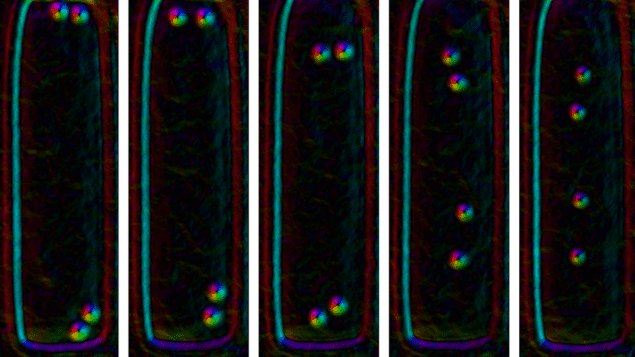
Interactions between individual 3D skyrmions have been measured by physicists in China, Sweden, Russia and Germany. Their study shows that the magnetic quasiparticles feel both attractive and repulsive forces, depending on the strength of an applied magnetic field. As well as providing insights into the fundamental physics of magnetic materials, the research could lead to the development of devices that store data using skyrmions.
Skyrmions were first proposed as a new type of fundamental particle in the 1950s by British physicist Tony Skyrme. While these hypothetical particles have never been seen, certain collective particle-like excitations (quasiparticles) in magnetic solids have been shown to behave much like skyrmions. These solid-state skyrmions resemble vortices and have topological stability, which means that they persist for very long times and are resilient to external perturbations such as noise. Skyrmions can be extremely small and be manipulated using relatively small amounts of energy. Together, these properties suggest that skyrmions could be used to make dense and energy efficient computer memories.
In this latest work, Mingliang Tian at the University of Science and Technology of China and colleagues studied a type of skyrmion that is created when a magnetic field is applied to a “nanostripe” of iron germanide (FeGe). These 3D skyrmions are tubular magnetic vortices with diameters of about 40 nm. They extend below the surface of the nanostripe and can move around in directions perpendicular to the applied magnetic field.
Edge effects
Using Lorentz transmission electron microscopy, the team observed the motions of individual skyrmions and then worked-out how the skyrmions interact with each other. They also studied how the skyrmions interact with the edges of the nanostripe, which was about 430 nm wide, 120 nm thick and 1600 nm long.
The team first looked at a nanostripe that contained tens of skyrmions. At relatively low magnetic fields (260 mT), the skyrmions formed chains or clusters at or near the edges of the nanostripe. As the field strength was increased to 390 mT, the clusters and chains moved away from the edges to the centre of the nanostripe – where the cluster and chain configurations were maintained. When the field was turned up to 480 mT the clusters and chains broke apart and the skyrmions were distributed across the centre of nanostripe.
Writing in Physical Review Letters, Tian and colleages surmise that the chain and cluster formation at low magnetic fields is the result of an attractive interaction between skyrmions. The migration of the skyrmions away from the edges and the subsequent break-up of the chains and clusters suggests that both the skyrmion-skyrmion and skyrmion-edge interactions become repulsive at higher magnetic fields.
Pair potential
However, the team points out that clustering can also occur in systems of particles with repulsive interactions and so to get a better understanding of the interaction they looked at the behaviour of individual pairs of skyrmions.
Their second experiment began at low magnetic field and with two pairs of skyrmions – one pair at each end of the FeGe nanostripe (see figure). As the magnetic field was increased from 200 mT to 500 mT, the team measured the distance between the two skyrmions in a pair. They also measured the distances between individual skyrmions and the edge of the nanostripe.
The initial separation between skyrmions in a pair was about 75 nm and this increased very slowly until the magnetic field reached about 450 mT. Then, the separation jumped to about 200 nm where it saturated by the time the magnetic field reached 470 mT. The distance between a skyrmion and the edge of the nanostripe was about 50 nm at low fields and increased to 200 nm and saturated there at about 420 mT.
Similar behaviour was seen in reverse as the magnetic field was reduced back down to 200 mT. This, the team says, shows that the observed interactions are real – rather than the result of skyrmions being pinned by defects in the FeGe nanostripe.
Theoretical agreement
The experiments reveal that the skyrmion-edge interaction switches from attractive to repulsive at a significantly lower field than the switch that occurs in skyrmion-skyrmion interaction. The team also did theoretical calculations, which suggest that the observed behaviour can be explained using our current understanding of 3D skyrmions.
The research could lead to a better understanding of the possible density at which skyrmions could be packed together in a memory device, and how data could be stored and retrieved from such devices.
In the audio interview below, Mohit Randeria of the Ohio State University tells Hamish Johnston why physicists are interested in skyrmions.



